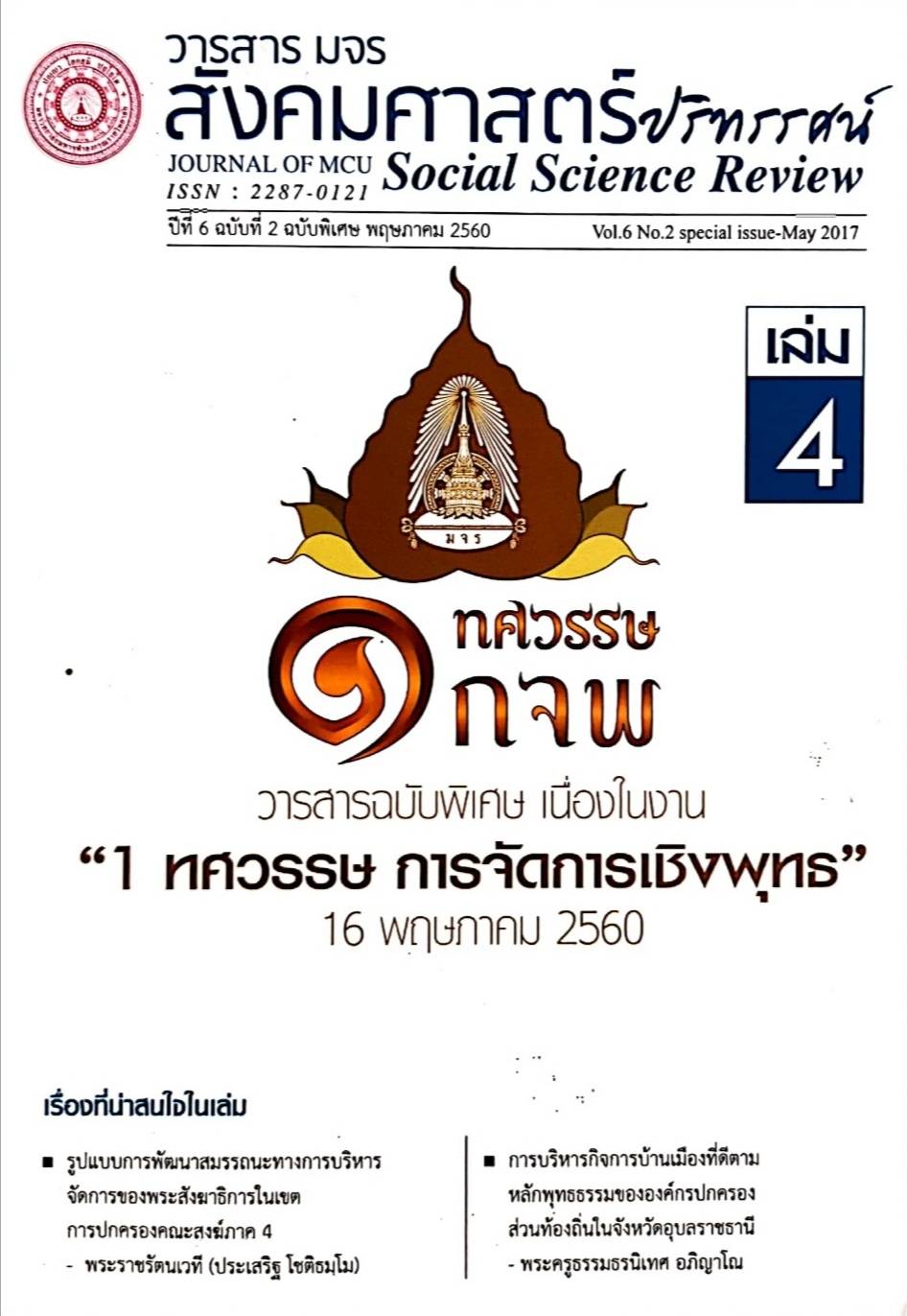การพัฒนารูปแบบการปกครองคณะสงฆ์ภาค 18
คำสำคัญ:
การพัฒนา, รูปแบบ, การปกครอง, คณะสงฆ์ภาค 18บทคัดย่อ
บทความวิจัยนี้มีวัตถุประสงค์ 1) เพื่อศึกษาสภาพและปัญหา การปกครองคณะสงฆ์
ภาค18 2) เพื่อศึกษาแนวคิด และหลักพุทธธรรมการปกครองคณะสงฆ์ภาค 18 และ 3) เพื่อ
นาเสนอการพัฒนารูปแบบการปกครองคณะสงฆ์ ภาค 18
การวิจัยครั้งนี้เป็นการวิจัยเชิงคุณภาพ โดยแบ่งผู้ให้ข้อมูลหลักเป็น 2 กลุ่ม คือ (1)
ผู้ให้ข้อมูลหลักในการสัมภาษณ์ ประกอบด้วยพระสังฆาธิการในระดับเจ้าคณะผู้ปกครอง
พระสงฆ์ และนักวิชาการด้านพระพุทธศาสนาที่เกี่ยวข้องกับการปกครองคณะสงฆ์ภาค 18
จานวน 30 รูป/คน (2) กลุ่มผู้ร่วมสนทนากลุ่มประกอบด้วย ผู้เชี่ยวชาญและผู้มีส่วนได้ส่วนเสีย
จานวน 10 รูป/คน เก็บรวบรวมข้อมูล โดยการสัมภาษณ์เจาะลึก และการสนทนากลุ่ม และ
วิเคราะห์ข้อมูลใช้วิธีการวิเคราะห์เนื้อหาเชิงพรรณา
ผลการวิจัยพบว่า
1. สภาพและปัญหาการปกครองคณะสงฆ์ภาค 18 มีพื้นที่ปกครอง 6 จังหวัด (1)
จังหวัดสงขลา (2) จังหวัดพัทลุง (3) จังหวัดสตูล (4) จังหวัดปัตตานี (5) จังหวัดยะลา (6) จังหวัดนราธิวาส ปัญหาอุปสรรคในการปกครอง แบ่งออกเป็น 2 ประเด็น (1) ปัญหาภายใน
องค์กร จานวนบุคลากรน้อย บุคลากรที่มีอยู่ยังขาดความสามารถในด้านการปกครอง การ
ประสานงานระดับบนลงล่างขาดความประสิทธิภาพ การอบรมพัฒนาบุคลากรขาดความ
ต่อเนื่อง เจ้าคณะผู้ปกครองระดับสูงอยู่นอกพื้นที่ เมื่อเกิดปัญหาเร่งด่วนแก้ไขไม่ทันการณ์ ขาด
ขวัญกาลังใจ (2) ปัญหาภายนอก บางจังหวัดเป็นพื้นที่เสี่ยงภัย เกิดเหตุการณ์ความไม่สงบอยู่
เป็นประจา การเดินทางสัญจรไม่ปลอดภัย จานวนพุทธศาสนิกชนมีน้อย วัดร้างเพิ่มขึ้น การ
สนับสนุนจากภาครัฐมีน้อยไม่ทั่วถึง และขาดความสะดวกในการทากิจกรรมทางศาสนาในพื้นที่
จาเป็นต้องได้รับการแก้ไขเร่งด่วน
2. แนวคิดและหลักพุทธธรรมในการปกครองปกครองคณะสงฆ์ภาค 18 ในปัจจุบัน
เป็นการปกครองภายใต้พระราชบัญญัติการปกครองคณะสงฆ์ พ.ศ. 2505 แก้ไขเพิ่มเติม (ฉบับ
ที่ 2 ) พ.ศ.2535 ซึ่งมีมหาเถรสมาคม จานวน 21 รูป มีสมเด็จพระสังฆราชเป็นประธาน
จัดเป็นองค์กรสูงสุดในปกครองคณะสงฆ์ ได้ออกกฎ ระเบียบ มติ และประกาศ มหาเถรสมาคม
ให้พระภิกษุสามเณร อุบาสก อุบาสิกาได้ปฏิบัติตาม เป็นการปกครองแบบสั่งการบนลงล่าง
กาหนดชั้นการปกครอง 6 ชั้น คือ (1) เจ้าคณะใหญ่ (2) เจ้าคณะภาค (3) เจ้าคณะจังหวัด
(4) เจ้าคณะอาเภอ (5) เจ้าคณะตาบล (6) เจ้าอาวาส กากับดูแลภายในวัดให้เรียบร้อย มี
ตาแหน่งปกครองที่เป็นพระสังฆาธิการ 12 ตาแหน่ง (1) เจ้าคณะใหญ่ (2) เจ้าคณะภาค (3)
รองเจ้าคณะภาค (4) เจ้าคณะจังหวัด (5) รองเจ้าคณะจังหวัด (6) เจ้าคณะอาเภอ (7) รองเจ้า
คณะอาเภอ (8) เจ้าคณะตาบล (9) รองเจ้าคณะตาบล (10) เจ้าอาวาส (11) รองเจ้าอาวาส
(12) ผู้ช่วยเจ้าอาวาส มีการสั่งการปกครองเป็นลาดับชั้นตอน มีหลักอปริหารนิธรรมเป็นกรอบ
ในการปกครองให้เกิดความเรียบร้อยดีงาม
3. การพัฒนารูปแบบการปกครองคณะสงฆ์ภาค 18 ที่พัฒนาแล้ว ได้รูปแบบเป็น
วิธีการ คือต้องมีการหมั่นประชุมวางแผนกันเนืองนิตย์ พร้อมเพรียงกันทากิจตามแผนงาน
กระบวนการที่ตกลงกันไว้ ไม่ล่วงละเมิดข้อบัญญัติที่ได้ตกลงกันในที่ประชุม เคารพต่อมติของที่
ประชุม ให้ความเคารพเชื่อฟังต่อประธานสงฆ์ที่อาวุโส ที่ทาหน้าที่ในการปกครอง โดยไม่ลุ
อานาจที่เกิดจากความอยาก เปิดใจรับฟัง มีความยินดีในเสนาสนะอันสะอาด สงัด เพื่อการ
บาเพ็ญเพียรทางจิต และตั้งความปรารถนาดีต่อผู้ที่มีศีล ให้เข้ามาสู่สานักของตน อยู่กันด้วย
อย่างสงบสุข
เอกสารอ้างอิง
Education Administration. Bangkok : Department of Religious Printing.
Herbert A. Simon, Donald W, Smithburg and Viotor A, Thompson. (2009). Public
Administration. New York: Alfred A. Knope. Inc.
Joyce. Bruce., and Weil, Marsha. (1986). Model of Teaching. Englewood Cliffs :
Prentice-Hall International Editions.
Pha Brahmgunabhon ( P.A. Payutto). (2546). Dictionary of Buddhism . 12th
edition. Bangkok : Mahachulalongkornrajavidyalaya Printing.
Pha Dhampitaka ( P.A. Payutto). (2541). Buddhist jurisprudence. Bangkok :
Buddhadhama Foundation.
Phra Chot Bodeerat.(2555). The Buddhist Sangha Administration for Buddhism
stability in Region 4 of the Buddhist Sangha Administration. (Doctoral
Dissertation). Bangkok: Valaya Alongkorn Rajabhat University
Phrakhrusantithammapirat (Booncahi Santikaro). (2557). The Development of
Sangha Administration Model in 15ThRegion Sangha Administration.
(Doctoral Dissertation). Bangkok: Mahachulalongkornrajavatha
yalaya University.
Phramaha Taruti Virocano ( Rungchaiwithoon).(2556). Pattern of Human
Resource Development of Sangha Administrators for Efficiency of
Sangha Administration. (Doctoral Dissertation). Bangkok: Maha
chulalongkornrajavathayalaya University.
Phratheprattanasuthee ( Somsak Chotitaro). (2557). The Stratgy of Sangha
Administation in Sangha Administrative Region 1.(Doctoral
Dissertation). Bangkok: Mahachulalongkornrajavathayalaya University.
The Royal Academy.(2546). Dictionary of Royal Academy BE. 2542. Bangkok :
Nanmee Publications.
Yuwat Wuthimedhi. (2526). Community Development and Rural Development
Principles. Bangkok : Thai Anukrothai .
ดาวน์โหลด
เผยแพร่แล้ว
รูปแบบการอ้างอิง
ฉบับ
ประเภทบทความ
สัญญาอนุญาต
ลิขสิทธิ์ (c) 2020 วารสาร มจร สังคมศาสตร์ปริทรรศน์

อนุญาตภายใต้เงื่อนไข Creative Commons Attribution-NonCommercial-NoDerivatives 4.0 International License.
เพื่อให้เป็นไปตามกฎหมายลิขสิทธิ์ ผู้นิพนธ์ทุกท่านต้องลงลายมือชื่อในแบบฟอร์มใบมอบลิขสิทธิ์บทความให้แก่วารสารฯ พร้อมกับบทความต้นฉบับที่ได้แก้ไขครั้งสุดท้าย นอกจากนี้ ผู้นิพนธ์ทุกท่านต้องยืนยันว่าบทความต้นฉบับที่ส่งมาตีพิมพ์นั้น ได้ส่งมาตีพิมพ์เฉพาะในวารสาร มจร สังคมศาสตร์ปริทรรศน์ เพียงแห่งเดียวเท่านั้น หากมีการใช้ภาพหรือตารางหรือเนื้อหาอื่นๆ ของผู้นิพนธ์อื่นที่ปรากฏในสิ่งตีพิมพ์อื่นมาแล้ว ผู้นิพนธ์ต้องขออนุญาตเจ้าของลิขสิทธิ์ก่อน พร้อมทั้งแสดงหนังสือที่ได้รับการยินยอมต่อบรรณาธิการ ก่อนที่บทความจะได้รับการตีพิมพ์ หากไม่เป็นไปตามข้อกำหนดเบื้องต้น ทางวารสารจะถอดบทความของท่านออกโดยไม่มีข้อยกเว้นใดๆ ทั้งสิ้น





